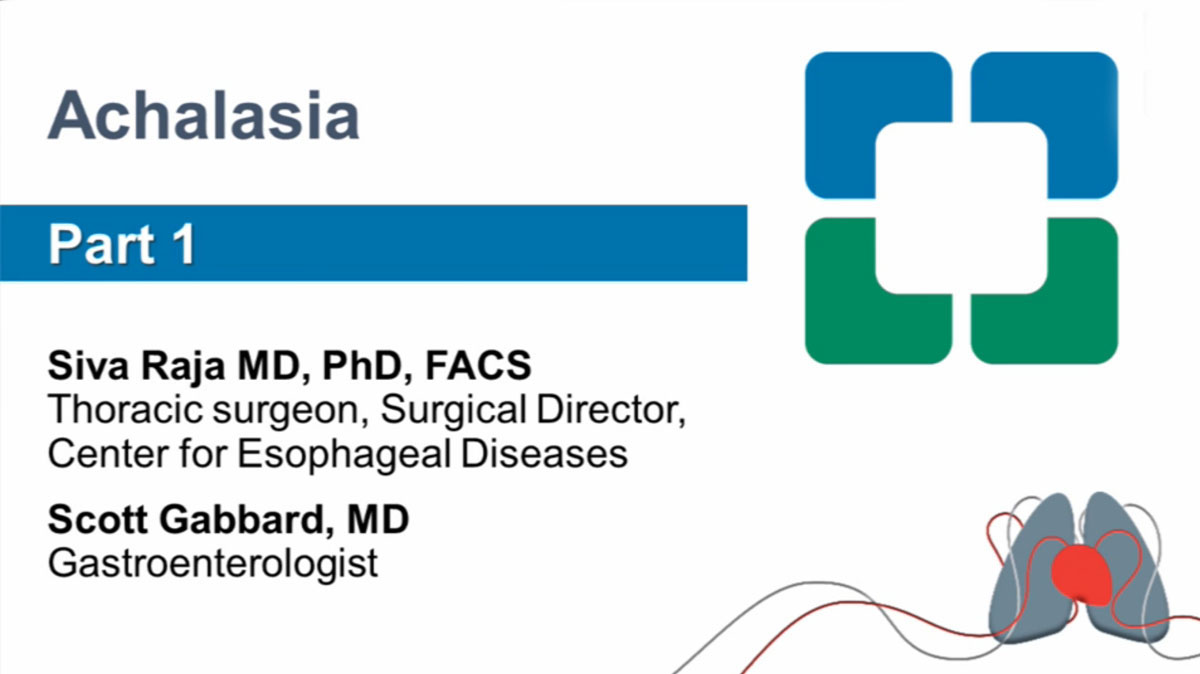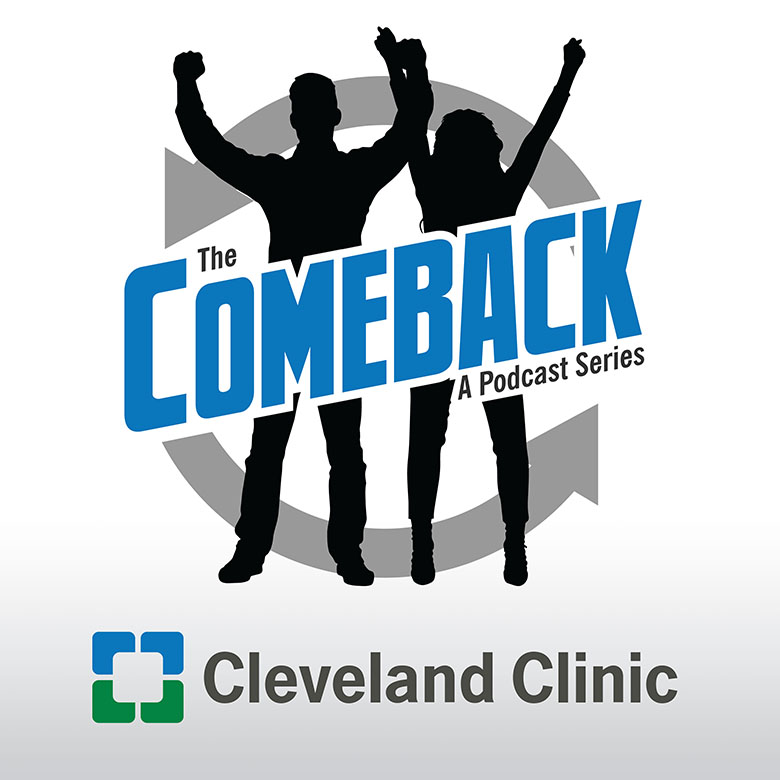Achalasia Part 1

Achalasia Part 1 - The Basics: Diagnosis, Symptoms, Treatment, and Recovery.
In this three part program, achalasia experts thoracic surgeon Dr. Siva Raja and gastroenterologist Dr. Scott Gabbard answer all the questions commonly asked by patients with symptoms of achalasia, going through diagnostic testing or being treated for achalasia.
Achalasia Part 1
What is it?
How is it diagnosed?
What are the symptoms?
What are the treatments?
How is recovery?
How do people feel after surgery?
Who should get what procedure?
Are types of achalasia related to treatment
Are you at risk for cancer if you have achalasia?
What is involved in long term treatment of achalasia?
What happens if your symptoms occur again after you have had surgery?
What are the outcomes of treatments?
Subscribe: Apple Podcasts | Podcast Addict | Buzzsprout | Spotify
Achalasia Part 1
Podcast Transcript
Announcer: Welcome to Love Your Heart, brought to you by Cleveland Clinic's Sydell and Arnold Miller Family Heart and Vascular Institute. These podcasts will help you learn more about your heart, thoracic and vascular systems, ways to stay healthy and information about diseases and treatment options. Enjoy.
Dr. Siva Raja: Today we're going to be talking about achalasia. It's a rare condition that not many people see often, but here we have a center that's dedicated to it. And so we're going to be talking about achalasia. And today I have with me Dr. Scott Gabbard from our swallowing center and he's going to tell us what achalasia is, and if you think you have achalasia, how do we find out if you have it?
Dr. Scott Gabbard: Great.
Dr. Siva Raja: Scott?
Dr. Scott Gabbard: So achalasia is pretty rare. One in 10,000 people have it. And what it is is a valve disorder of the esophagus. Typically you've got a ring valve at the bottom of your esophagus that opens when you swallow. And in achalasia them primary problem is that the valve does not open. Additionally, your esophagus doesn't squeeze correctly. So instead of the esophagus squeezing food through, the entire thing just gives a very weak squeeze. So you have a valve that doesn't open, an esophagus that doesn't squeeze well, and then patients end up with very severe difficulty swallowing. And the technical term for that is dysphasia.
So as I said, achalasia is a valve disorder, and the ways that we diagnose achalasia, the primary way is a test called manometry, and it's a thin tube, you can't see it, but this tiny little wire on our microphone or the wire on your mouse pad, it's a tube about that wide that goes into your nose, down into your esophagus, and it measures the muscle function of the esophagus, and it allows us to see if you're esophagus squeezes normally or, and if the valve opens correctly. It doesn't sound like the most pleasant test in the world. And I've had one myself, and I'll tell you, it's not the best part of your day, but you get through it. It's about 10 or 15 minutes, and it's a very valuable tool in order to make this diagnosis.
Here at the Cleveland Clinic, we do over 1,300 a year. So we are very experienced. We have incredibly experienced nurses who do this on a daily basis, and time and time again we hear patients say, "That test wasn't nearly as bad as when I had it done at my local hospital".
Dr. Siva Raja: Can I ask you a question? So what kind of symptoms would somebody have, would make them want to think that they may have achalasia?
Dr. Scott Gabbard: So the classic symptoms are the sensation of food or liquid getting stuck in the esophagus when you swallow. So you feel food or solids gets stuck in the chest. Sometimes patients can get heartburn or regurgitation. The sensation of liquids and solids coming back after swallowing. Very often this gets misdiagnoses as acid reflux disease.
So often we see patients who had been diagnosed with acid reflux disease for years, have been on multiple medicines for acid reflux, not getting better. They come to us and they say, "I feel regurgitation, things getting stuck in my chest," and we make the diagnosis right then and there with the manometry.
Dr. Siva Raja: Is there anything else they need in addition to manometry, do you think?
Dr. Scott Gabbard: Yeah. So I think another very helpful test is a barium swallow with a special protocol that funny enough was developed here at the Cleveland Clinic about 25 years ago, where patients drink a standardized amount of liquid barium and our radiologists take an x-ray picture at one, three and five minutes, and measure how much liquid barium is left in the esophagus.
For normal individuals that barium should go right through the esophagus. Someone with achalasia that barium may stick much longer than five minutes. So that's an easy test. It's not as specific, not quite as helpful as manometry, but it does add some very useful information. And lastly, an endoscopy. Often many patients have had endoscopy by the time they come to us and their docs have said they have a normal scope. However, we see enough achalasia that we can tell very subtle changes in the esophagus that may clue us in to a patient having achalasia on endoscopy, that their local physician missed.
In particular, I think we saw well over 175 patients with achalasia last year. So we get very in tuned to minor abnormalities that we can pick up that other physicians who don't get to see achalasia as much might have missed.
Dr. Siva Raja: So once you've decided that the tests all point to the fact that they have achalasia, what do you have to offer them to treat this?
Dr. Scott Gabbard: Yeah, that's a great question. So there right now are at least four therapies for achalasia. One thing we take pride in is individualizing the treatment to the patient. It's all too often we go to our meetings and we hear someone stand up and say, "All achalasias should be treated with this one maneuver". And that's just not true. We here individualize it. We have multiple treatment modalities. I think the longest standing treatment is doing surgery called a Heller myotomy, where the surgeon like Dr. Raja would go in laparoscopically and cut the valve. That's been done for well over a hundred years.
Now they do it laparoscopically with a few small incisions. The nice part about that is obviously if you cut the valve, you have a wide open channel for food to go down, but then you can have bad reflux of all those stomach contents coming up after the fact. So one nice thing that I've seen you do is you make a new valve so that things go down but not back up, and that cuts down the rate of reflux quite considerably. Patients have a great benefit of difficulty swallowing less reflux.
Another option that's been around for over 30 years is dilating with a special balloon. We go down with the scope and we blow up a very large balloon specifically designed for Heller myotomy called a pneumatic dilator, and that will actually open the muscle by making microscopic tears in the muscle. That has been done for well over 30 years. It's nice that it's an endoscopic procedure and not a surgery. However, it's not as successful as surgery. Again, it may be reasonable for the right patient.
New to achalasia over the last 10 years is endoscopically, through a scope, Dr. Raja and colleagues have started cutting the valve through the mouth, and this is a new surgery called POEM. Quite exciting, it's been done around the world for about 10 years now and patients are getting very good results. The downside to POEM is that you can't make a new valve currently, so patients have a higher rate of having reflux after that surgery. Again, there are specific populations where that might be optimal compared to the other surgeries I mentioned. However, every patient it needs to be individualized.
Lastly, if a patient's not a candidate for surgery, we can go in with the scope and inject Botox into the valve to paralyze the muscle, open it up. The downside to Botox is it only lasts for six to 12 months. So patients require multiple injections over their lifetime. So we don't here offer that to someone who's otherwise a candidate for the therapies I mentioned previously.
Dr. Siva Raja: Yeah. The good thing is these days we have minimally invasive treatments for achalasia. And as Dr. Gabbard mentioned, we have the Heller myotomy. It's been around for 100 years, but we're doing them with really small incisions. We're using the surgical robot. All of that's made the recovery from that very, very easy and quick, but it's still an operation.
But when we open the valve, the concern for everybody obviously is heartburn. And I think the operation that we use to give the flap afterwards has really made a big difference in how people do long term. Because you remember Achalasia is not cancer and it's something, it's a chronic condition that you've got to live with. So it's important to make the quality of life afterwards pretty good. And once the operation is done, I can say that universally people are substantially better after the operation than before the operation.
We may not be able to get you back to how it was 20 years ago, but I think it's, life is still pretty good.
Announcer: Thank you for listening. We hope you enjoyed the podcast. We welcome your comments and feedback. Please contact us at heart@ccf.org. Like what you heard? Please subscribe and share the link on iTunes.

Love Your Heart
A Cleveland Clinic podcast to help you learn more about heart and vascular disease and conditions affecting your chest. We explore prevention, diagnostic tests, medical and surgical treatments, new innovations and more.


